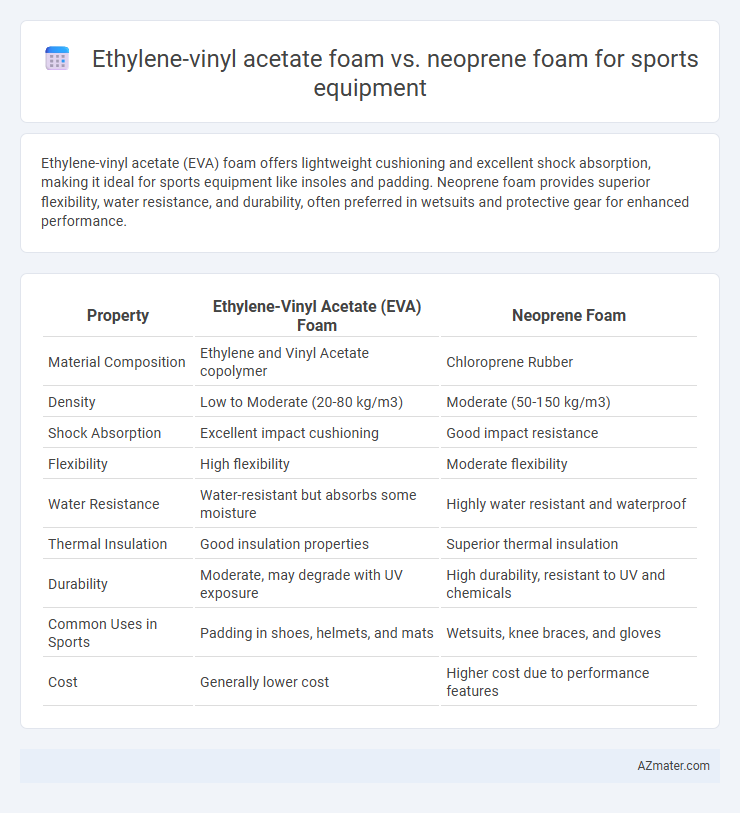Ethylene-vinyl acetate (EVA) foam offers lightweight cushioning and excellent shock absorption, making it ideal for sports equipment like insoles and padding. Neoprene foam provides superior flexibility, water resistance, and durability, often preferred in wetsuits and protective gear for enhanced performance.
Table of Comparison
| Property | Ethylene-Vinyl Acetate (EVA) Foam | Neoprene Foam |
|---|---|---|
| Material Composition | Ethylene and Vinyl Acetate copolymer | Chloroprene Rubber |
| Density | Low to Moderate (20-80 kg/m3) | Moderate (50-150 kg/m3) |
| Shock Absorption | Excellent impact cushioning | Good impact resistance |
| Flexibility | High flexibility | Moderate flexibility |
| Water Resistance | Water-resistant but absorbs some moisture | Highly water resistant and waterproof |
| Thermal Insulation | Good insulation properties | Superior thermal insulation |
| Durability | Moderate, may degrade with UV exposure | High durability, resistant to UV and chemicals |
| Common Uses in Sports | Padding in shoes, helmets, and mats | Wetsuits, knee braces, and gloves |
| Cost | Generally lower cost | Higher cost due to performance features |
Introduction to Ethylene-Vinyl Acetate (EVA) and Neoprene Foams
Ethylene-vinyl acetate (EVA) foam is a lightweight, flexible material known for its excellent shock absorption, making it ideal for sports equipment such as padding and insoles. Neoprene foam exhibits superior durability, water resistance, and thermal insulation, commonly used in wetsuits, braces, and protective gear. Both foams provide cushioning and impact protection but differ in chemical composition, elasticity, and environmental resistance, influencing their specific applications in athletic gear.
Key Properties of EVA Foam in Sports Equipment
Ethylene-vinyl acetate (EVA) foam offers exceptional shock absorption and lightweight cushioning, making it ideal for sports equipment like shoe soles, protective padding, and insoles. Its closed-cell structure provides excellent water resistance and durability against repeated impacts, contributing to enhanced athlete comfort and injury prevention. Compared to neoprene foam, EVA foam exhibits superior flexibility and thinner profile options, optimizing mobility and performance in various sports applications.
Core Features of Neoprene Foam for Athletic Use
Neoprene foam boasts superior flexibility, excellent shock absorption, and high durability, making it ideal for sports equipment that requires reliable cushioning and support. Its resistance to water, oils, and temperature variations ensures consistent performance during intense athletic activities. Enhanced elasticity and thermal insulation properties contribute to improved comfort and protection in sports gear like knee braces, gloves, and wetsuits.
Cushioning and Impact Absorption: EVA vs Neoprene
Ethylene-vinyl acetate (EVA) foam offers superior cushioning and impact absorption for sports equipment due to its lightweight, flexible structure and excellent shock-absorbing properties, reducing strain during high-impact activities. Neoprene foam provides moderate cushioning with enhanced durability and resistance to compression, making it ideal for protective gear requiring consistent performance under repeated stress. EVA's closed-cell composition ensures better energy dispersion, while neoprene excels in maintaining form and resilience over time.
Durability and Longevity Comparison
Ethylene-vinyl acetate (EVA) foam offers superior flexibility and resistance to water absorption, making it highly durable for sports equipment subjected to frequent impact and moisture exposure. Neoprene foam excels in longevity due to its exceptional resistance to heat, chemicals, and UV radiation, which prevents degradation over extended outdoor use. Both materials provide reliable cushioning, but EVA foam is preferred for shock absorption while neoprene ensures longer-lasting performance in harsh environmental conditions.
Moisture Resistance and Water Performance
Ethylene-vinyl acetate (EVA) foam offers superior moisture resistance compared to neoprene foam, making it highly effective for sports equipment exposed to sweat and water. EVA foam exhibits excellent water repellency and quicker drying times, reducing the risk of mold and odor development. Neoprene foam, while providing good cushioning and flexibility, tends to absorb more water, which can compromise durability and increase weight during prolonged use in wet conditions.
Flexibility and Comfort in Sports Applications
Ethylene-vinyl acetate (EVA) foam offers superior flexibility and lightweight cushioning, making it ideal for sports equipment requiring enhanced shock absorption and comfort. Neoprene foam provides excellent elasticity and thermal insulation, maintaining consistent flexibility in variable temperatures, which supports joint stability and muscle protection during intense activities. Both materials excel in comfort, but EVA is preferred for impact resistance while neoprene is favored for flexibility and moisture resistance in sports applications.
Cost-effectiveness and Material Availability
Ethylene-vinyl acetate (EVA) foam offers superior cost-effectiveness for sports equipment due to its lower production costs and widespread availability, making it a preferred choice for budget-conscious manufacturers. Neoprene foam, while more expensive, delivers enhanced durability and resistance to weather, which can justify higher upfront costs in specialized applications. Material availability favors EVA foam as it is produced globally with diverse suppliers, whereas neoprene is more limited and often sourced through specific chemical manufacturers, impacting lead times and price stability.
Common Sports Equipment Using EVA and Neoprene
Ethylene-vinyl acetate (EVA) foam is commonly used in sports equipment such as shin guards, helmets, and yoga mats due to its lightweight, cushioning, and impact absorption properties. Neoprene foam is favored for wetsuits, knee braces, and gloves because of its excellent flexibility, water resistance, and thermal insulation. Both materials offer distinct advantages tailored to specific sports applications, with EVA preferred for shock absorption and neoprene for durability and protection in wet environments.
Choosing the Right Foam: Factors and Recommendations
Ethylene-vinyl acetate (EVA) foam offers superior shock absorption, flexibility, and lightweight properties, making it ideal for cushioning in sports equipment such as insoles, padding, and helmets. Neoprene foam provides excellent durability, chemical resistance, and thermal insulation, which benefits protective gear requiring resilience against moisture and temperature variations. Choosing the right foam depends on specific needs: EVA for enhanced comfort and impact protection, neoprene for durability and environmental resistance in demanding athletic conditions.

Infographic: Ethylene-vinyl acetate foam vs Neoprene foam for Sports equipment
 azmater.com
azmater.com